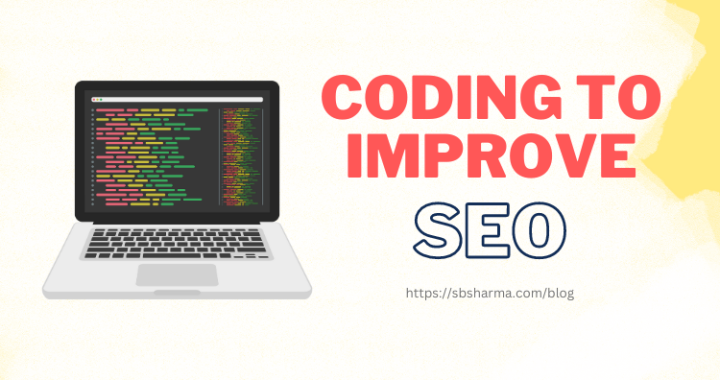How to Use Coding to Improve Your Website’s SEO Ranking?

Let’s understand about how to use coding to improve your website’s SEO.
In today’s computerized landscape, having a robust web-based presence is significant for businesses be it a desktop or mobile app. You may make a good mobile app by taking external mobile app development services but for people to know about your app, you need excellent SEO.
Good news! You don’t have to be an SEO expert to improve your website’s SEO ranking. By making some simple changes to your website’s code, you can enhance its search engine optimization (SEO) and attract more visitors.
In this article, we’ll explore how coding can be used to improve your website’s SEO ranking, using easy-to-understand examples.
What is SEO Ranking?
SEO ranking is all about where your website lands on search engines like Google or Bing when someone searches for something online. It’s like your website’s position in the lineup of search results. A bunch of things, like how closely your content matches the search words and the quality of other websites linking to yours, decide where you show up.
The better your ranking, the more people are likely to see your website when they search, which can lead to more visitors and better online success. Curious to dig deeper into the world of SEO? Let’s explore!
1. Optimize Your Website’s Loading Speed
Website loading speed is an essential factor in deciding user experience and SEO ranking. Slow-loading websites frustrate users as well as get lower orders from search engines. To optimize your website’s loading speed, consider the accompanying coding techniques:
a. Limit HTTP Requests: Lessen the quantity of HTTP requests by consolidating numerous CSS files into a single record and compressing images.
b. Empower Browser Reserving: Influence browser storing by setting termination headers, permitting returning visitors to stack your website faster.
c. Diminish Redirects: Redirects increase the time it takes to stack a page. Keep away from unnecessary redirects to improve loading speed.
2. Carry out Portable First Design
With the increasing use of cell phones for web browsing, search engines focus on versatile websites. A portable first design approach ensures your website is responsive and accessible across various devices. Consider the accompanying coding practices:
a. Responsive Website architecture: Use CSS media queries to make responsive layouts that adjust to various screen sizes.
b. Versatile Route: Execute a route menu that is easy to use on smaller screens, such as a collapsible menu or a burger symbol.
c. Optimize Images: Use responsive images and appropriate picture compression techniques to decrease load times on cell phones.
3. Use Structured Information Markup
Structured information markup, or schema markup, provides search engines with extra data about your website’s substance. By executing structured information markup, you can improve your website’s visibility in search results. Consider the accompanying coding techniques:
a. Execute JSON-LD: Use JSON-LD (JavaScript Item Documentation for Connected Information) to incorporate structured information into your website’s HTML easily.
b. Distinguish Key Elements: Use schema markup to feature significant elements on your website, such as item details, reviews, ratings, and occasion data.
c. Approve Your Markup: Test your structured information using Google’s Structured Information Testing Tool to ensure its precision and appropriate execution.
4. Optimize Your Website’s Metadata
Metadata provides search engines with essential data about your website’s substance. Advancing your metadata using coding techniques can improve your website’s visibility on SERPs. Consider the accompanying practices:
a. Title Tags: Use significant keywords in your title tags to give a concise and precise description of every site page.
b. Meta Descriptions: Compose convincing meta descriptions that captivate users to tap on your website’s connection in search results.
c. Header Tags: Appropriately structure your substance using header tags (H1, H2, H3, and so on) to make it more comprehensible and understandable for the two users and search engines.
5. Optimize Your Website’s URLs
User-accommodating and SEO-accommodating URLs can improve your website’s visibility and navigate rates. Consider the accompanying coding techniques:
a. Use Descriptive URLs: Remember pertinent keywords for your URLs to give users and search engines a reasonable understanding of your page’s substance.
b. Execute Canonical Tags: Use canonical tags to keep away from copy content issues and consolidate connect value to the favored version of a website page.
c. Eliminate Dynamic Parameters: If possible, eliminate unnecessary influential parameters from your URLs to make them more user-accommodating and search motor agreeable.
Conclusion
Coding advancement can significantly affect your website’s SEO ranking, that’s how you can use coding to improve your website’s SEO. By carrying out the above mentioned techniques, you can improve your website’s loading speed, versatility, structured information markup, metadata, and URLs. You can also use a WordPress to build your website as it has lot of SEO plugins to automate your SEO related work.
Remember, SEO is a continuous process, so routinely monitor your website’s presentation, stay aware of the latest coding practices, and adjust your strategies promptly. With the proper coding techniques, you can upgrade your website’s visibility, draw in more natural rush hour gridlock, and, at last, accomplish higher rankings on search motor result pages.




